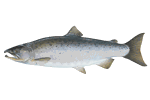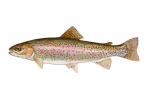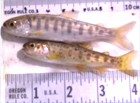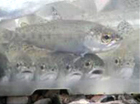Salmonids in the Gualala
Two salmonid populations, Coho salmon (Oncorhynchus kisutch) and Steelhead Trout (Oncorhynchus mykiss) are present in the Gualala Watershed. Historical anecdotal information also indicates that Chinook salmon (Oncorhynchus tshawytscha) may have been found in the main-stem reaches.
The salmonid lifecycle involves adults maturing in the ocean, migrating back to their home streams and spawning, embryos incubating, fry emerging, juveniles growing, and smolts migrating to the estuary to acclimate to saltwater and moving out into the ocean. Each phase require use of and access to distinct habitats.
Salmonids have been highly adaptable in the past. Since the last ice age, some 10,000 to 15,000 years ago, they have adjusted to a wide variety of locations, habitat and climatic conditions.
During the past two centuries, logging, irrigation, grazing, pollution, commercial and sport fisheries, dams, and residential and commercial development have constrained salmonid populations at every stage of their life cycle. Coho are now on the Federal Endangered Species list and steelhead trout are listed as Threatened.
 Coho
Coho
Coho salmon, also known as silver salmon, typically enter the river to spawn in September through December. The young emerge from their redd and spend at least one full year in the river before smolting and migrating to the ocean. After maturing in the ocean for 16 to 18 months they return to their natal streams to spawn and then die.
Historic Populations
Coho inhabited the streams flowing from the coniferous forest in the lower Gualala basin. They were likely sub-dominant to steelhead in the interior basin due to the more open nature of the channels, less suitable habitat, and naturally warmer stream temperatures.
There are no statistical surveys for Coho populations in the Gualala. Anecdotal evidence provides a convincing case that coho salmon populations in the Gualala River were large and experienced a decline prior to the 1960s.
Habitat
Coho need riverine habitats that include cool clean water, appropriate water depth and flow velocities, riparian vegetation to stabilize soil and provide shade, clean gravel for spawning and egg-rearing, large woody debris to provide resting and hiding places, adequate food and varied channel forms.
In the Gualala Coho habitat is limited to the North Fork basin and more specifically, the Doty and Robinson Creek Planning watersheds where small and possibly not self-sustaining coho populations have been observed during snorkel and electrofishing surveys.
Coho Listing
The Gualala River Watershed lies within the Central California Coast Coho Salmon Evolutionary Significant Unit (ESU), which is listed as endangered under the Endangered Species Act (NMFS 2005).
Critical habitat includes all river reaches and estuarine areas accessible to coho salmon within the ESU’s geographic area (NMFS 1999).
 Steelhead Trout
Steelhead Trout
Steelhead are the anadromous form of rainbow Trout, a salmonid species native to western North America and the Pacific Coast of Asia.
They enter the Gualala River to spawn starting in late December through April. After the young emerge they spend their first 1 to 3 years of life in the watershed before smolting and migrating to the ocean.
After spending between one to four seasons maturing in the ocean, Steelhead return to their native fresh water stream to spawn. Unlike Pacific Salmon, Steelhead do not necessarily die after spawning and are able to spawn more than once.
Historic Populations
Starting in the 1940s and continuing today Steelhead have been recreationally fished on the Gualala River. The California Department of Fish and Game conducted steelhead population surveys in 1976 and 1977 and found Steelhead populations to be 7,608 and 4,324 respectively.
Habitat
Steelhead habitat requirements are very similar to coho salmon. They need cool clean water and adequate flow for migration and summer rearing, clean gravels and cobble for spawning and winter refugia, deep pools with large wood for shelter, and healthy riparian vegetation for shade and nutrients.
Steelhead are more adaptable to warmer water temperatures and are found in most tributaries throughout the watershed.
Steelhead Listing
Winter run Steelhead in the Gualala river basin are part of the Northern California Steelhead Distinct Population Segment (DPS) and are listed as threatened under the Federal ESA (NMFS 2006).



